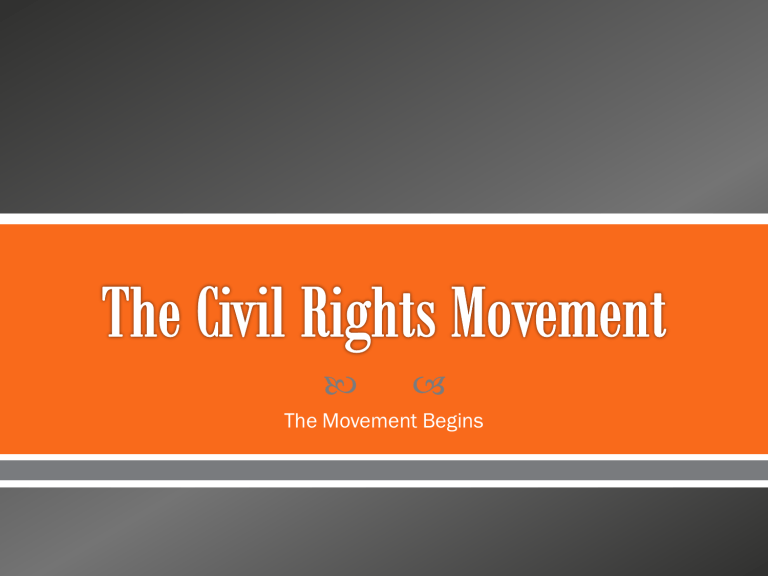The Civil Rights Movement

The Movement Begins
The origins of the movement
•When Rosa Parks agreed to challenge segregation in court, she did not know that her decision would launch the modern civil rights movement.
•Many African Americans had decided it was time to demand equal rights.
•Jim Crow laws were common throughout the South, but segregation existed in other states as well.
-Court Challenges Begin
•In 1953, the supreme court ruled in Norris V. Alabama that
Alabama’s exclusion of African Americans from juries violated their right to equal protection under the law.
• Morgan V. Virginia that segregation on interstate buses was unconstitutional.
• Sweatt V. Painter that state law schools had to admit qualified African American applicants, even if parallel black law schools existed.
-New Political Power
•Most African Americans lived in the South, where they were largely excluded from voting.
•During migration, many moved to northern cities, where they were allowed to vote.
•During the 1930’s, many African Americans benefited from
FDR’s New Deal programs.
-The Push for Desegregation
•During World War II, African American leaders began to use their new political power to demand more rights.
•Their efforts helped end discrimination in factories that held government contracts and increased opportunities for African
Americans in the military.
• James Farmer and George Houser founded the Congress of
Racial Equality, CORE began using sit-ins.
•CORE attempted to desegregate restaurants that refused to serve African Americans, Using the sit-in strategy.
•CORE successfully integrated many restaurants.
-Brown V. Board of Education
•The NAACP’s chief counsel
•Thurgood Marshall
•One of the cases involved a young African American girl named Linda Brown, who was denied admission to her neighborhood school in Topeka, Kansas, because of her race.
•Brown V. Board of Education-segregation in public schools was unconstitutional.
The Southern Manifesto
•The court ordered school districts to proceed “with all deliberate speed” to end school segregation.
•In 1956 a group of 101 Southern members of congress signed the Southern Manifesto.
•The Southern Manifesto encouraged white Southerners to defy the Supreme court.
The Montgomery Bus Boycott
•Outraged by Park’s arrest.
•African Americans boycott Montgomery’s buses for over a year
•The boycott was a success
•Meeting held at Baptist church where Dr. King was pastor.
•He believed that the only moral way to end segregation and racism was through nonviolent passive resistance.
•King drew upon the philosophy and techniques of Indian leader
Mohandas Gandhi.
•The Southern Christian Leadership Conference (SCLC), set out to eliminate segregation from American society and to encourage African
Americans to register to vote.
•Dr.King served as the SCLC’s first president.
Crises in Little Rock
• President Eisenhower disagreed with segregation, however, he worried that challenging white Southerners on segregation might divide the nation and lead to violence.
•He refused to endorse Brown V. Board of Education.
•In September 1957, the school board in Little Rock, Arkansas, won a court order to admit nine African American students to Central
High, a school with 2,000 white students.
•He became the first president since reconstruction to send federal troops into the South to protect the constitutional rights of AA.
•He ordered troops from the Arkansas National Guard to prevent the nine African American students from entering class.
•The Governor of Arkansas, Orval Faubus, had used the armed forces of a state to oppose the authority of the federal government, the first such challenge to the Constitution since the Civil War.
•The district court ordered ordered the governor to remove the troops.
•Angry whites beat at least two African American reporters and broke many of the school’s windows.
•Federal authority had to be upheld, president ordered the U.S. Army to send troops to Little Rock.
•African American students arrived in an army wagon, and they walked into the school with armed military personnel, the law had been upheld.
New Civil Rights Legislation
•The Civil Rights Act of 1957 was intended to protect the right of African Americans to vote.
•Eisenhower believed in the right to vote, and he viewed it as his responsibility to protect voting rights.
•Several Southern senators did try to stop the Civil Rights Act of 1957.
•President Johnson put together a compromise that enabled the act to pass.
Explain how the Great Migration and the Great Depression contributed to the new political power for African
Americans. Describe how these two events resulted in this new power.
Explain how the Great Migration and the Great Depression contributed to the new political power for African Americans.
Describe how these two events resulted in this new power.
o
Before WWI, the vast majority of African Americans lived in the South, where they were largely excluded from voting.
During the Great Migration, many African Americans moved to
Northern cities where they were allowed to vote. Increasingly,
Northern politicians sought the votes of African Americans and listened to their concerns. During the Great Depression, many African Americans benefited from Franklin Roosevelt’s
New Deal programs and voted for him in record numbers.
Their votes gave the Democratic Party new strength in the
North, where Republicans had dominated ever since the Civil
War. They forced the Democratic Party to pay attention to civil rights issues and helped counter the powerful Southern
Democrats, many of whom strongly supported segregation.






